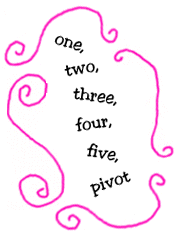 I’ve been busy with a house guest and my new pup lately. Not only was she perfect company, dear friend Michelle arrived on my doorstep with books in hand. We also made a trip to a used bookstore last weekend, where I found another eight for the collection.
I’ve been busy with a house guest and my new pup lately. Not only was she perfect company, dear friend Michelle arrived on my doorstep with books in hand. We also made a trip to a used bookstore last weekend, where I found another eight for the collection.
One of them is Ruth Tolman’s Charm and Poise for Getting Ahead, and here is an important excerpt for you all.
1969: Techniques for a Graceful Walk
![]() Poise and balance are synonymous. If a beautiful walk is anything, it is well balanced. Walking on a line like a tight rope walker will give you balance; this is the beginning of learning to walk well. It is the beginning, but not the end. Obviously, there is more than this that goes into a beautiful walk.
Poise and balance are synonymous. If a beautiful walk is anything, it is well balanced. Walking on a line like a tight rope walker will give you balance; this is the beginning of learning to walk well. It is the beginning, but not the end. Obviously, there is more than this that goes into a beautiful walk.
First of all, a beautiful walk should appear effortless and smooth. This calls for the most efficient movement possible. The muscles must take over and let go at precisely the right moment. They must work at optimum tension. The direction of the walk must be forward, not up and down or from side to side.
You must not ‘settle’ with each step. You must think tall and light. You must keep your weight forward toward the balls of the feet. To check this, stand with your feet side by side, close your eyes and imagine that you are a puppet being pulled up and up by strings attached to the crown of your head and to your ears. Where is your weight? It’s definitely not on your heels and never should be as you walk. Carry your weight just in front of the ankle bone. If you sink onto your heels your walk will lack the “heavenly” quality that reaching for the sky will give it.
Keep your chest high. The grace of your arms, neck and head depend upon your chest position. If it is balanced over the feet, the shoulders will act as ballast so that your entire torso from the waistline up will seem like a ship skimming over calm seas.
Keep your chin up. You don’t want to lose by a head. There’s something queenly about the woman who carries her head held high. What’s the saying about it’s better to see the stars in the sky than the mud on the ground?
Acquire an evenly spaced momentum. How fast or slow you walk will depend upon your personality. Most of all, you should look for a nice balance between the slouching, idling gait and the ‘going to a fire’ gait that looks harassed. Whatever the speed of the rhythm you choose, let it be a natural rhythm that will vitalize your movements.
Rhythm makes the difference. It will be helpful if you can do your walking practice to music, if not, count aloud to yourself in soft and relaxed tones, ‘One, two, three, four, five, pivot; one, two, three, four, five, pivot.’![]()
Source: Tolman, Ruth. Charm and Poise for Getting Ahead. Bronx, NY: Milady Publishing Corporation, 1969.
~ p. 83 ~